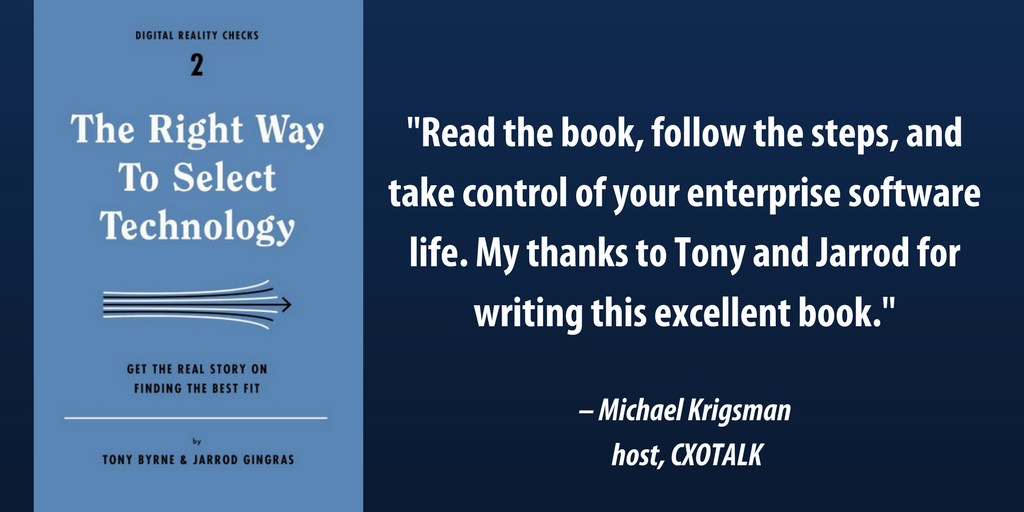Tech Selection Tips #16 - Make the Right Final Selection

Based on what transpired in the competitive PoC phase, as well as cost-value considerations, your final step in your technology selection journey is to decide on the ultimate solution. In my experience — after hands-on exposure to the technology, vendor, and potentially implementation team — a clear winner typically emerges. You just want to ensure that you’ve taken a full measure of the choices before signing any contract.
Taking the Full View
At this stage, you want to ensure that you’re taking a holistic view of what life would be like with this particular solution. As you evaluate the two offerings, put together all the pieces:
- Reference checks
- Vendor/partner fit
- Technology/solution fit
- Ecosystem
- Pricing and terms

The strength of the vendor's ecosystem could have as much impact on your success as its technical fit.
What If You Can't Decide?
If the team still can’t make a decision, then you likely have an institutional disconnect that new technology will not solve and perhaps will even aggravate.
The selection team chair may become tempted to apply a decision here by fiat, but we’d encourage you to reconsider: if after vigorous empirical testing and analysis the team remains split, then you should reassess your bearings. Perhaps you are not considering the right marketplace, or you are asking too much of one solution, or the organization simply isn’t ready for new technology.
Or perhaps you need to address some deep-seated internal conflicts. Much like the arrival of children never solves marital woes, implementing software never mends internal business rifts.
Yet we are happy to report that in the vast majority of cases, if you follow the methods in this series, a clear winner will emerge. Now you’ll want to set yourself up for success going forward.
Planning for Success
As a first step, you’ll need to identify the inevitable shortcomings of the winning system. Perhaps the interface remains a bit cluttered. Or there are small hitches with the way it integrates with your identity management environment. Get prepared to communicate this to other colleagues to avoid unpleasant surprises, but also devise mitigation plans so that you can reduce the impact of those drawbacks.
Also, you will almost certainly need to plan for internal process and information changes. Perhaps the new system will support a more streamlined workflow, but this will still necessitate staff cooperation and understanding. Or the new platform will enable personalized customer experiences, but this will require new content variants; someone needs to compose that material. The longer you put off business change, the more you will postpone obtaining value from your new technology.
Tips
- Conduct and review reference checks.
- Don’t underestimate “vendor intangibles” in considering overall fit.
- Ask more questions and continue testing beyond the PoC if significant questions or concerns remain outstanding.
- Revisit implementation strategy, plans, and pricing.
- Incorporate the latest results from ongoing financial and contract negotiations.
- Hold off on licensing the complete solution until you finish the next (pilot) phase.
- Make a list of problems and shortcomings with the winning system so that you can work on mitigation plans.
Next Steps
If you're selecting digital workplace or marketing/engagement technology, be sure to check out RSG's hard-hitting vendor evaluation research.
Other Posts in This Series
- Tip #1: Articulate a Solid Business Case
- Tip #2: Build the Right Team
- Tip #3: Setting the Right Business Foundations
- Tip #4: Capture Requirements That Don't Suck
- Tip #5: User Stories Are Everything
- Tip #6: Ask Questions That Really Matter
- Tip #7: Find More Than the Usual Suspects
- Tip #8: Target the Right Suppliers
- Tip #9: How to Engage Vendors
- Tip #10: Create RFPs That Actually Work
- Tip #11: Keeping It Real with Bidders
- Tip #12: Evaluate Proposals Critically
- Tip #13: Hold Demos on Your Own Terms
- Tip #14: Run Competitive Bake-Offs
- Tip #15: Negotiate Like a Pro
- Tip #16: Make the Right Final Selection
- Tip #17: Select the Right Services Provider
Buy the book








